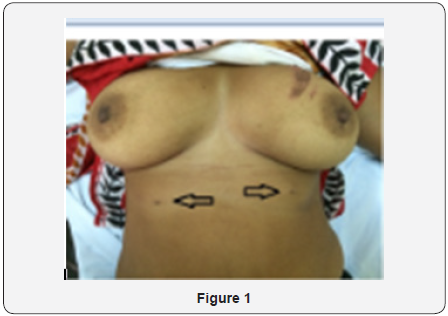Bilateral Accessory Breast: A Case Report from Nepal-Juniper Publishers
Juniper Publishers-Open Access Journal of Head Neck & Spine Surgery
Bilateral Accessory Breast: A Case Report from Nepal
Authored by Tuhin Shah
Bilateral Accessory Breast: A Case Report from Nepal
Authored by Tuhin ShahIntroduction
Accessory or ectopic breast tissue is residual breast
tissue that persists after normal embryonic mammary development. It can
occur anywhere along the embryonic mammary streak, but is most commonly
located in the axilla. Accessory breast tissue can consist of any
component of the breast and may be functional or non-functional and its
development is hormone dependent like normal breasts. Overall, the
prevalence of accessory breast tissue in women ranges from 0.4% to 6%,
and in men, from 1% to 3% [1]. Usually they are asymptomatic and do not
need any intervention unless they start causing discomfort. Diagnosis of
accessory breast tissue is important because they are subject to all
diseases of the breast including carcinomas [2]. Here we report a case
of asymptomatic accessory breast tissue in bilateral chest wall of a
32-year Nepalese multi Para female patient.
Case Description
A 32-year-old multi Para woman presented with
swelling over bilateral lower chest. Physical examination revealed two 5
X 5cm each sized lobular, soft, non-tender, diffuse masses in bilateral
lower chest wall over 8th costal cartilage in the mid clavicular line.
The overlying skin had a 1cm pigmented center each which was the
nipple-areola complex. The mass was not adherent to the underlying
structures and was separate from both breasts. There was no discharge
from the masses or the breasts. Both breasts were clinically normal and
there was no enlargement of axillary, cervical, supraclavicular lymph
nodes (Figure 1). She had no other medical problems, no past history or
family history of cancer. Routine blood examinations were within normal
limits. Ultrasonography of these masses showed ectopic breast tissue
with normal ultrasound of the abdomen, breast and axilla.

On questioning she does not recall any problems or
symptoms arising from these masses during the pubertal or pregnancy
period. This is a case of asymptomatic bilateral accessory or ectopic
breast tissue.


Comments
Post a Comment